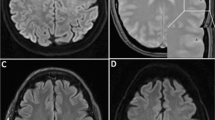Abstract
Watershed infarcts can involve the brainstem, with lesions distributed across the terminal supply from the vertebral and cerebellar arteries. Brain imaging can highlight a comma-shaped lesion at the edge of vertebral and posteroinferior cerebellar artery vascularization territory. Such peculiar MRI lesion shape might suggest a watershed hypoperfusion etiology and direct workup towards causes of hemodynamic impairment, including postural hypotension, cardiac failure, or vertebral artery origin occlusion.

Similar content being viewed by others
References
Sparaco M, Ciolli L, Zini A (2019) Posterior circulation ischaemic stroke—a review part I: anatomy, aetiology and clinical presentations. Neurol Sci 40:1995–2006
D’Amore C, Paciaroni M (2012) Border-zone and watershed infarctions. Front Neurol Neurosci 30:181–184
Li Y, Li M, Zhang X et al (2017) Clinical features and the degree of cerebrovascular stenosis in different types and subtypes of cerebral watershed infarction. BMC Neurol 17:166
Abdelrasoul AA, Elsebaie NA, Gamaleldin OA et al (2019) Imaging of brain infarctions: Beyond the usual territories. J Comput Assist Tomogr 43:443–451
Koch S, Amir M, Rabinstein AA et al (2005) Diffusion-weighted magnetic resonance imaging in symptomatic vertebrobasilar atherosclerosis and dissection. Arch Neurol 62:1228–1231
Mangla R, Kolar B, Almast J, Ekholm SE (2011) Border zone infarcts: pathophysiologic and imaging characteristics. Radiographics 31:1201–1214
Yin W-M, Nagata K, Satoh Y et al (1994) Infratentorial infarction: correlation of MR findings with neurological and angiographical features. Neurol Res 16:154–158
Barbut D, Grassineau D, Lis E et al (1998) Posterior distribution of infarcts in strokes related to cardiac operations. Ann Thorac Surg 65:1656–1659
Renard D, Broner J, Le Floch A (2014) Pontine watershed infarction. Acta Neurol Belg 114:141–142
Regenhardt RW, Das AS, Stapleton CJ et al (2017) Blood pressure and penumbral sustenance in stroke from large vessel occlusion. Front Neurol 8:317
Kurowski D, Mullen MT, Messé SR (2016) Pearls & Oy-sters: iatrogenic relative hypotension leading to diffuse internal borderzone infarctions and coma. Neurology 86:e245–e247
Webb AJS, Mazzucco S, Li L, Rothwell PM (2018) Prognostic significance of blood pressure variability on beat-to-beat monitoring after transient ischemic attack and stroke. Stroke 49:62–67
Funding
No funds, grants, or other support was received.
Author information
Authors and Affiliations
Corresponding author
Ethics declarations
Conflict of interest
The authors declare they have no relevant financial or non-financial interests to disclose.
Ethical approval
All procedures performed in the studies involving human participants were in accordance with the ethical standards of the institutional and/or national research committee and with the 1964 Helsinki Declaration and its later amendments or comparable ethical standards.
Informed consent
Informed consent was obtained from all individual participants included in the study.
Additional information
Publisher’s note
Springer Nature remains neutral with regard to jurisdictional claims in published maps and institutional affiliations.
Supplementary Information
Below is the link to the electronic supplementary material.
ESM 1
(DOC 3174 kb)
Rights and permissions
About this article
Cite this article
Merli, E., Romoli, M., Gentile, M. et al. Bulbar watershed ischemic stroke: the comma-shaped sign—a case series. Neuroradiology 63, 1947–1950 (2021). https://doi.org/10.1007/s00234-021-02754-3
Received:
Accepted:
Published:
Issue Date:
DOI: https://doi.org/10.1007/s00234-021-02754-3




